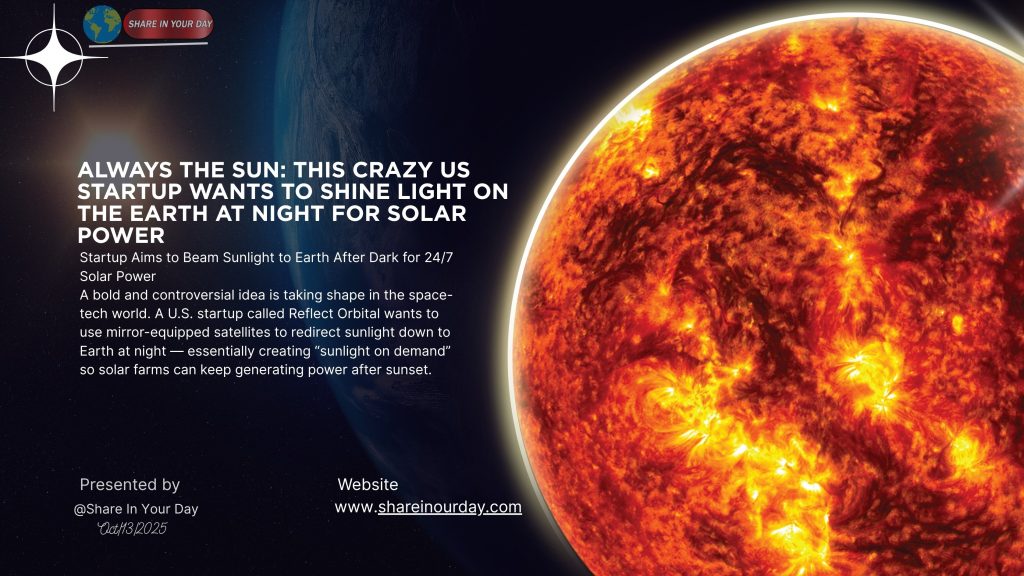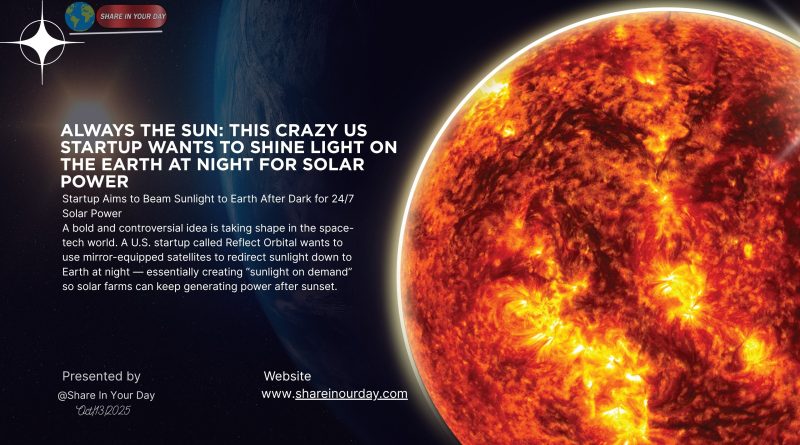Startup Aims to Beam Sunlight to Earth After Dark for 24/7 Solar Power
A bold and controversial idea is taking shape in the space-tech world. A U.S. startup called Reflect Orbital wants to use mirror-equipped satellites to redirect sunlight down to Earth at night — essentially creating “sunlight on demand” so solar farms can keep generating power after sunset.
Ambition and Skepticism in Equal Measure
Their first demonstration vehicle, Earendil-1, is an 18-metre test satellite expected to launch in 2026. Over the longer term, the company envisions a fleet of up to 4,000 satellites in orbit by 2030
But scientists and astronomers are raising serious concerns — not just about practical constraints, but also about the environmental and observational consequences.
How It’s Supposed to Work
The concept is simple in theory: reflect sunlight off mirrors on orbiting satellites, directing it to targeted ground locations. Think of bouncing light off a watch onto a wall—just on a much grander scale.
However, the physics complicate things. The Sun is not a point source; it spans about half a degree of angular size. That means when you reflect sunlight over hundreds of kilometers, the beam spreads out, limiting how tightly you can focus light on the ground. A large 54-metre mirror in low Earth orbit would produce illumination 15,000 times weaker than direct noon sunlight — still brighter than a full moon, but not nearly enough for full solar power.
In ground tests using a balloon-borne 2.5 m mirror, the team achieved about 516 W/m² at 242 meters. That’s around half of full midday sun — an encouraging result locally, but scaling up to space distances would require enormous mirrors (or vast numbers of them) to have impact.
Practical and Timing Challenges
- Short illumination windows: At ~625 km altitude, satellites zip around Earth at ~7.5 km/s. That means any given beam would sweep over a location for mere minutes. To sustain illumination, thousands of satellites might be needed.
- Massive scale needed: To reach just 20% of midday sun’s intensity, Reflect Orbital would require on the order of 3,000 satellites per location. Ambitious proposals even mention 250,000 satellites in total.
- Orbit design constraints: The company plans to use sun-synchronous orbits above the terminator (day/night boundary) so their mirrors are always in sunlight and can best direct light to Earth
Light Pollution & Astronomical Risks
Astronomers view this vision with alarm. Mirror satellites intentionally beaming light down would create unprecedented light pollution. Some beams might be almost as bright as the Sun when seen from Earth, posing risks to telescopes and even eye safety. FOR every one
Even if beams are “targeted” and “predictable,” satellite motion inevitably means stray beams might sweep across unintended areas, lighting up skies in unpredictable ways. This would severely interfere with astronomy, affect nocturnal wildlife, and alter the character of the night. SHARE IN YOUR DAY
Reflect Orbital says it will share satellite tracking data so observatories can plan around the beams. But critics argue that the scale of the system is likely to overwhelm such mitigations. SHARE IN YOUR DAY
Why It’s Worth Watching (or Worrying)
The project is still speculative. The test satellite may launch, but going from one reflector to thousands is a huge leap. If realized, the idea could help extend solar power’s reach — but at a steep cost to dark skies and scientific observation.
As night skies risk being lit artificially, we’ll have to debate whether the energy benefits are worth the environmental and cultural trade-offs.
If you like, I can also turn this into a shorter “insight / op-ed” version, or a version focused on technical feasibility for engineers. Which would you prefer?





